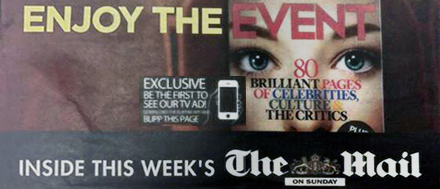When it comes to digital technology, don’t be afraid to spell it out
Mobile Strategies | 05 May 2013

My father-in-law and I enjoy what you might call a mutually beneficial relationship.
If I need a job done around the house or office that I can’t do myself, rather than calling in a (paid) plumber, electrician, or whatever type of handyman is required, I call him instead. And he fixes it. To be fair, if it’s something in the office, like the dishwasher he recently plumbed in, we do the decent thing and pay him a modest fee to cover his time.
In return, I am his personal tech support. In the same way that plumbing is a dark art to me, so it is with my father-in-law and PCs, tablets, and mobiles.
So it’s rare we get together without him presenting a list of his current problems and issues.
Last weekend, he caught me as I was flipping burgers for our first barbecue of the summer, and asked me about all this stuff in the newspaper about scanning the pages for more information.
The current edition of the magazine that comes with his favourite Sunday newspaper, he explained, was full of such messages. But when he held up his phone to the article in question in camera mode, nothing happened.
I promised to investigate.
After lunch, I asked him to find me one of the articles. He produced the Mail on Sunday’s Event magazine and turned to the motoring pages. Sure enough, there was an article about a new Ferrari, together with instructions to scan the page for more information.
Alongside the article was a small box with a blue “B” in it. So it was as I had suspected. The “B” stands for “Blippar,” a UK augmented reality (or, in their words, “image recognition”) tech firm that has made great strides in recent years with a host of large brands, including several publishers, to bring their static, on-page content to readers’ tablets and smartphones.
Now, Blippar knows its stuff and is keen for the verb “to blip” to become part of the English language, in the same way Shazam encourages its users to “Shazam a song” to retrieve information about what it is and who sings it.
I wish Blippar well in this enterprise, but it’s not there yet.
What was lacking when I flipped through the pages of the Event magazine was any sort of clue about what the “B” stood for. Also missing were instructions on what, precisely, you needed to do to access the additional content, i.e., go to the relevant app store for your device, download the Blippar app, fire it up, and then scan the content to access the additional information.
Interestingly, this information was present and correct alongside some “blippable” content in the London Metro newspaper a couple of weeks ago.
To be fair, the instructions were present and correct on the magazine’s contents page, but the fact that my father-in-law had no idea what to do suggests that they were not prominent enough.
At an event just a couple of days ago, there was a similar discussion around QR codes. Love ’em or loathe ’em, QR codes do offer a way of bridging the divide between the offline and online worlds.
But like the Mail on Sunday’s Blippar deployment, engagement rates will surely depend heavily on whether or not the reader knows what they are and what they are supposed to do with them.
There may come a day when QR codes, augmented reality markers, and other digital calls to action are so familiar as to be second nature to all but the most hardened technophobes. But as the Event magazine experience shows, we’re not there yet.






























